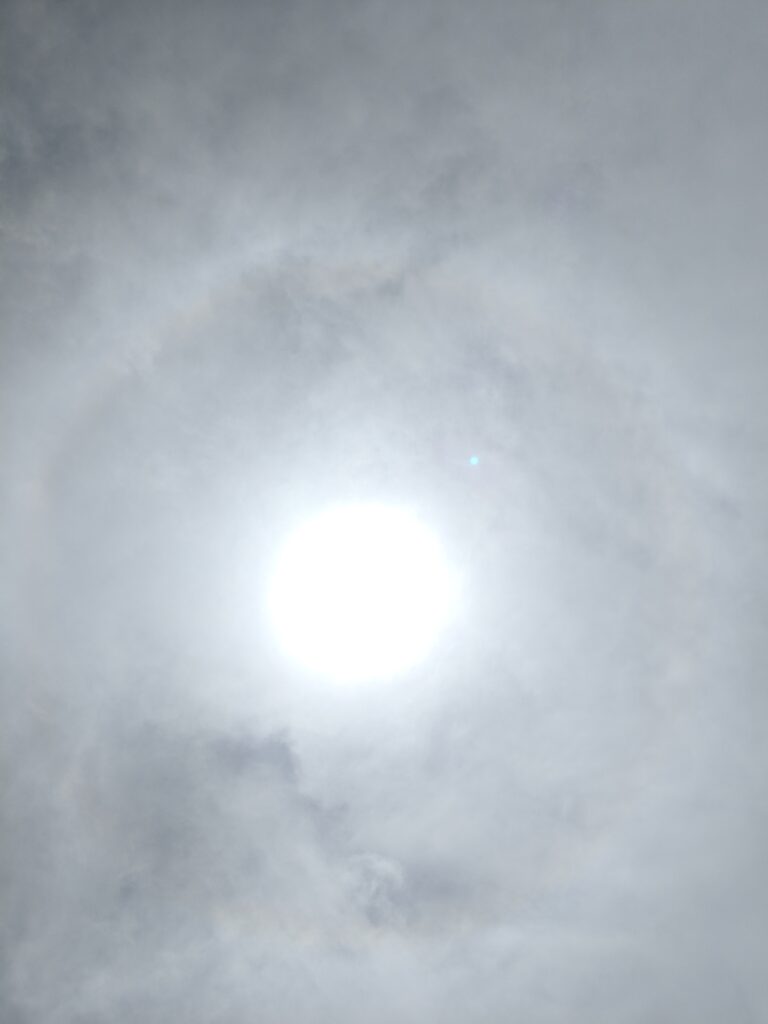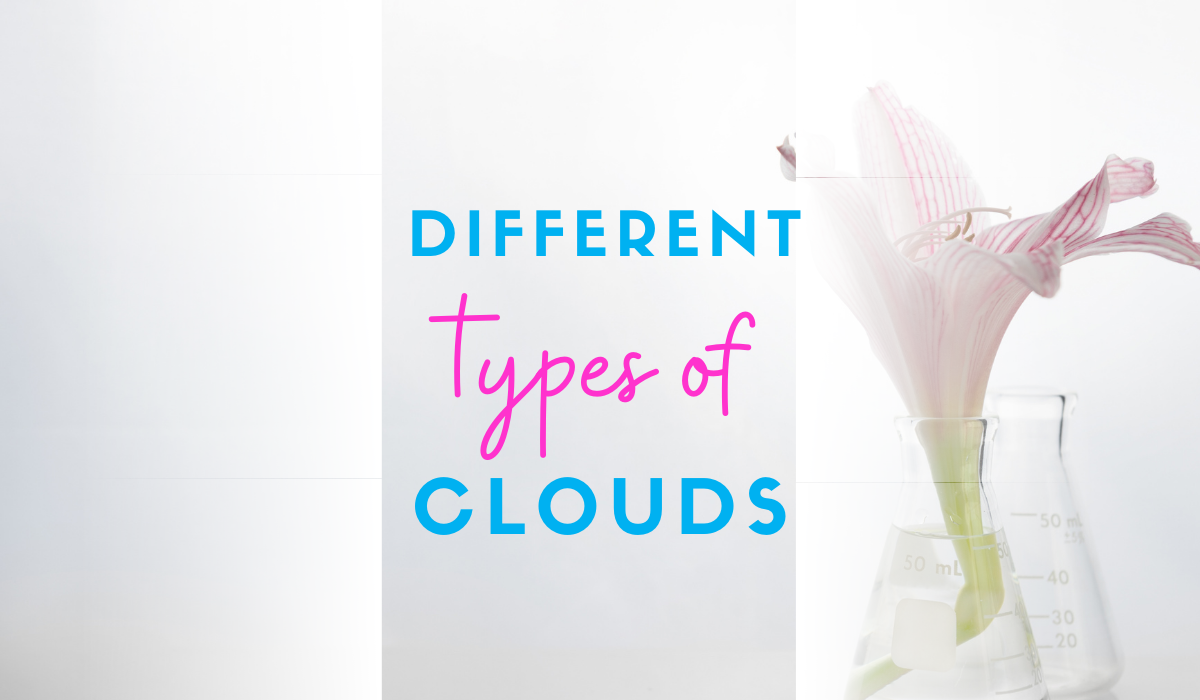I must say, I love teaching MANY topics in science, but teaching about the different types of clouds is one of my all time favorites. I mean, it’s truly so relevant. There are clouds in the sky almost every day. They help us predict weather, sometimes bring us little showers, and so much more. You can easily bring the WOW Factor with this topic!
How many different types of clouds are there?
There are many variations of clouds in the sky, but they can be classified 3 different levels and into 10 different types:
Levels
- High (cirrus, cirro-)
- Middle (alto-)
- Low (stratus, strato-)
Types
- Cirrocumulus
- Cirrostratus
- Cirrus
- Altocumulus
- Altostratus
- Nimbostratus
- Cumulus
- Stratocumulus
- Stratus
- Cumulonimbus
What are the different types of clouds?
High
Cirrocumulus clouds are high in the sky and consist of small white masses that are found in groups. They are made of a tiny amount of liquid water droplets. They generally occur at higher altitudes than altocumulus clouds. These clouds do not produce rain, but can be a sign that rain is approaching soon.
Cirrostratus are very thin and made of ice crystals. They often cover the entire sky. If these clouds are spread over the sky, it could mean that a storm is approaching. They usually appear 12-24 hours before rain or a storm.
Cirrus clouds are thin and featherlike. They are located very high in the sky, greater than 6,000 m. They come a variety of shapes and sizes and usually occur in fair weather. Their presence mainly indicates a change in weather is coming soon, usually within 24 hours.
Middle
Altocumulus clouds are puffy cloud fragments that usually are associated with changing weather. They are considered to be a warning clouds, meaning they are associated with potential rain or thunderstorm formation.
Altostratus clouds usually cover the whole sky and have a gray to bluish-green appearance. The sun or moon may appear blurry behind them. These clouds usually form before a continuous rain or snow, but sometimes rain will fall from an altostratus cloud.
Nimbostratus clouds are dark, gray, and featureless. They are usually thick enough to block out the sunshine, produce steady rain or snow, and are often associated with fronts. Rain from these clouds can bring hours of precipitation with no lightning and thunder being associated.
Low
Cumulus clouds are white and puffy clouds that usually mean good weather. They look like cotton candy. These clouds are flat at the bottom and at the top, have rounded towers.
Stratocumulus clouds are large, dark rounded masses. Rain usually does not come from these clouds; however, nimbostratus clouds are formed from them, and these clouds produce rain. You may see light drizzle come from stratocumulus clouds
Stratus clouds are flat and cover a large portion of the sky. Because of this, they are harder to recognize as clouds. They are gray clouds that sometimes produce a drizzle or light rain.
Cumulonimbus clouds are also known as thunderheads. They are associated with instability in the atmosphere that produce thunderstorms. One end of these clouds could be shaped like an anvil. They progress from cumulus clouds.
The Different Types of Clouds Activities

Digital Interactive Lesson
Digital interactive lessons are great for many reasons! I particularly like them as a lesson to be used in an inquiry-based flipped classroom. They are great for individual learning, direct instruction, science centers, and so much more! In this particular lesson, all 10 types of clouds are reviewed along with activities such a drag-and-drop, matching, multiple-choice, KWL, different types of clouds chart, Venn diagram, and more!
Digital interactive lessons are designed to decrease cognitive load. Students are only exposed to small bits of information at a time, and then they have to apply the information. They are broken down in a step-by-step sequential order to make learning easier.
Guess what else! They are easy for teachers too! A key is also included. Easy prep! I personally love the clouds digital interactive lesson. I love teaching about clouds!
This is a great lesson to use to teach the different types of clouds. Students love it!
Different Types of Clouds Project
So, I think one of the reasons that I love teaching about the different types of clouds so much is because of a project I had to complete when I was in the 9th grade where I had to take pictures of different types of clouds. I do not remember how long we had to do it, but it was probably a semester long project.
The project required us to:
- Take a picture of each type of cloud.
- Record the date that the picture what taken.
- Write a description of the cloud.
- Compile in some type of project form
I had fun with this! I actually remember getting an extra 10 points for my effort. On each page, I had used a hole puncher to make some dots, and then I glued polka dots on each page. It was beautiful! I can be a little extra sometimes. I loved that I was able to show my creativity with this project.
This is a great project to have your students to do!
Go Outside – Use a Field Guide
One of my favorite things to do when I’m teaching about the different types of clouds is to take my students outside to identify the types of clouds and the weather associated with these clouds. If they are clouds that bring severe weather or other precipitation, students can identify them from the window.
You can just choose to do this randomly throughout the school year or to have your students keep a log during a semester long project.
Students can choose to use a field, whether it be a paper field guide, or an app. Here is an awesome app by the UCAR Center for Science Education.

Gallery Walk
Gallery walks are fantastic activities for your students to learn to explore topics with multiple items to learn about such as the types of clouds. Do you hate giving lectures? Gallery walks are a great alternative to notetaking that allow for students to walk around the room and record their notes on an answer sheet.
You can just post a poster of each type of cloud, and students can explore each on for example, they can first walk over to the cirrus poster, record some notes, draw a picture, write a short definition, and a fun fact. Students can also jot down when they are likely to see this type of cloud in the sky.
Gallery walks allow for the students to take control of their learning and allows for the teacher to serve as a facilitator and to address individual student needs.
Which idea will you use for teaching the different types of clouds?
99 Engaging Strategies for Middle School Science
Need more ideas to engaged and motivate your middle school science students? Check out these 99 strategies that can be used in your science classroom to make sure that your students are engaged 100% of the time!
The diffferent type of clouds activities fit under these 99 strategies!


[…] would take my students out EVERY SINGLE YEAR for this one topic right here! Clouds! They are in the sky every day, well […]